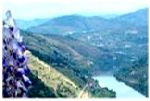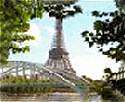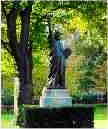|
In the basements of the
eastern and western pillars, one can visit the gargantuan 1899 hydraulic
machinery, designed by Gustave Eiffel, which still powers the elevators
[having been restored and computerized]. This is an astonishing
spectacle reminiscent of a Jules Verne novel.
Tower
Maintenance
Maintenance on the tower includes applying 50 metric tons of three
graded tones of paint every 7 years to protect the 200,000 square meters
of iron lattice work from rust. The darkest paint is used at the bottom
and the lightest shade at the top. Each repainting, by 25 painters
working for 15 months, requires 1500 brushes, 5000 sanding disks and
1500 sets of work clothes. On occasion, the color of the paint is
changed. The tower is currently painted to a shade of brown.
On the first floor, there are interactive consoles hosting a poll for
the color to use for a future session of painting. Depending on the
ambient temperature, the top of the Eiffel Tower will shift away from
the sun by eight centimeters because of expansion of the sun-warmed
metal.
Tower Operation
Of the 7.5 million kilowatt hours of electricity used annually, 580
thousand are used exclusively to illuminate the tower.
The
tower's annual operation also requires the use of 2 tons of paper for
tickets, 4 tons of rag or paper wipes, 10,000 applications of
detergents, 400 liters of metal cleansers and 25,000 garbage bags.
On the four facades of the tower, the 72 surnames of leading
turn-of-the-century
French scientists and engineers are engraved in recognition of their
contributions to science. This engraving was over painted at the
beginning of the 20th century and restored in 1986-1987 by SNTE [Société
Nouvelle d'Exploitation de la Tour Eiffel], a company contracted to
operate business related to the Tower [the Tower is owned by the City of
Paris].
Tower Happenings
During
its period of existence, the Eiffel Tower has witnessed a number of
strange scenes, including being scaled by a mountaineer in 1954 and two
Englishmen parachuting off it in 1984. The arrest of the infamous World
War I German Spy, the Danish dancer Mata Hari, was due to the
interception of one of her radio messages by the tower's
radiotelegraphic center.
In 1923, the journalist Pierre Labric [who was later to become mayor of Montmartre] rode a bicycle down
from the first level. Some accounts say he rode down the stairs while
others suggest that he rode on the exterior of one of the tower's four
legs which slope outward.
In 1925, a con artist by the name of
Victor Lustig, managed to sell the tower for scrap.
Politics
have also played a role in its life. During World War II, the Germans
hung a sign on it that read: "Deutschland Siegt Auf Allen Fronten"
["Germany is victorious on all fronts"]. In 1958, a few months before
Fidel Castro's rise to power, Cuban revolutionaries hung their
red-and-black flag from the first level and, in 1979, an American from
Greenpeace hung a sign reading: "Save the Seals". In 1989, the Tower
celebrated its centennial with music and fireworks [the show lasted 89
minutes].
The Tower and the Movies
The movie industry has always been fascinated by the Eiffel Tower which
can consequently be seen in hundreds of feature films, documentaries and
newsreels. Some of the movies it has appeared in are: North by
Northwest, The lavender Hill Mob, The War of the Worlds, The Great Race,
the James Bond movie and A View to a Kill. One of the great Hollywood
movie clichés is that the view from a Parisian window always includes
the Eiffel Tower. In reality, one can be a few hundred meters away from
the tower and unable to see it. |










